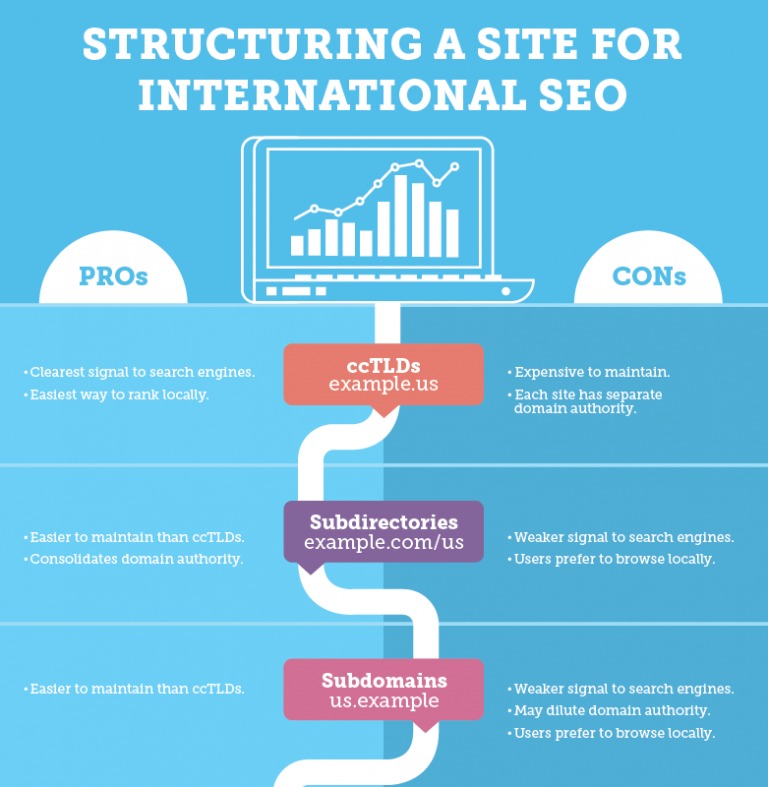International site structures can have a huge impact on the effectiveness of your global website strategy. It’s not just a technical decision. Connecting your technical goals with your business and marketing objectives could make all the difference to your international success.
There are typically three approaches you can take when it comes to international website structure. Understanding the pros and cons of site structure options in the context of your global content and international SEO strategy is key.
1. SITE STRUCTURES: THE CCTLD
If you’re targeting your international consumers by country, Country Code Top-Level Domains (or ccTLDs) are often considered the best approach. Since ccTLDs geo-target automatically, they can benefit the credibility and perception of your brand in-market. Examples of this include google.fr and amazon.de, both of which take you to country-specific, fully localized website experiences. This enables these global brands to deliver fully targeted content in the right language, truly connecting with their in-country audiences and improving local user experience.
However, despite these advantages, ccTLDs can be quite an investment and are probably best aligned for brands with a more mature global strategy. Since each domain is treated as a discrete website, ccTLDs require longer-term investment in growing site popularity and establishing domain authority from scratch.
For companies that don’t have Generic Top-Level Domains (or gTLDs), such as .com, .info, .net, .eu, or .org, ccTLDs can be limiting for international expansion. That’s because subdirectory geo-targeting is typically less effective within ccTLDs. For example, a Canadian company with the URL company.ca looking to expand into the US would have difficulty with a company.ca/us subdirectory approach because its ccTLD would continue to geo-target Canada automatically. The only workaround would be to purchase a new URL – like company.us and then apply relevant geo signals.
Pro tip: If you’re targeting purely by language, ccTLDs might not be the best option for you. But if you’d like the option to target by country in the future and offer a fully localized experience for each locale, it may be worth buying the ccTLDs now so you have them ready.
2. SUBDIRECTORIES WITH GTLD
The chief advantage of subdirectories with a gTLD (Generic Top-Level Domain) is that they can change with your business. They can be useful in targeting by country, by language, or by a combination of the two. Examples include spotify.com/fr, targeting France, and microsoft.com/en-gb, targeting the UK English audience.
If you’re using this approach, your localized sites will be able to leverage the existing domain authority of the gTLD. This gives it an SEO advantage over ccTLDs when targeting by country. From a technical perspective, this choice is popular since it’s relatively simple and scalable to implement, can generally be easier to maintain, and works well with hreflang attributes for international SEO.
3. SUBDOMAINS WITH GTLD
If you’re looking for an easy approach that allows for different server locations for different locales, subdomains with gTLD are an option. Examples include fr.wordpress.com and fr.wix.com.
However, much like ccTLDs, subdomains are generally considered separate entities. So you’ll have to work to develop their domain authority for each locale.
There is also quite a bit of evidence to suggest that the subdomain approach may impact international organic SEO performance, so talk to your SEO partner about the implications before going ahead with the technical implementation.

FINAL THOUGHT
Deciding on an international site structure can be difficult, but the most important thing is to be consistent. Take the time to consider what your current and long-term business goals are. And think about what you’re trying to achieve with your international sites. Develop a global site structure that supports your localization strategy. It should also meet your current and future technical, content, and marketing objectives. This will ensure you have a realistic and scalable plan for site maintenance and content management, good search visibility, and a better user experience. It will also save on time, resources, and budget in the long run.







